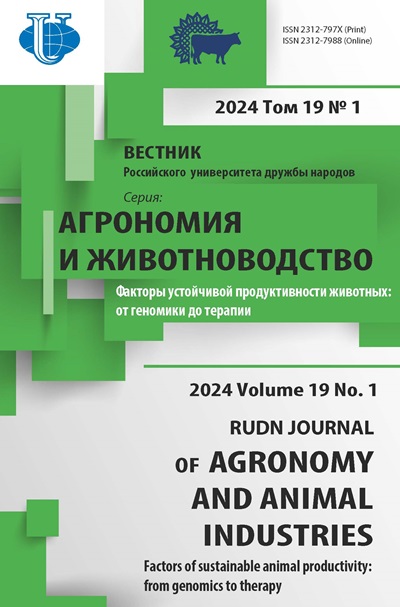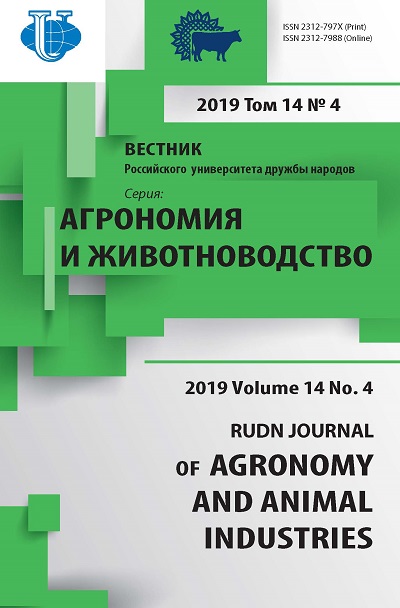Food security and sustainable crops production with considering climate change in China
- Authors: Shahrajabian M.H.1,2, Sun W.1,2, Cheng Q.1,2
-
Affiliations:
- Biotechnology Research Institute, Chinese Academy of Agricultural Sciences
- Nitrogen Fixation Laboratory, Qi Institute
- Issue: Vol 14, No 4 (2019)
- Pages: 423-429
- Section: Plant protection
- URL: https://agrojournal.rudn.ru/agronomy/article/view/19527
- DOI: https://doi.org/10.22363/2312-797X-2019-14-4-423-429
Cite item
Full Text
Abstract
Increase in the mean seasonal temperature can reduce the duration of many crops which may lead to final yield reduction. China needs to cope with the adverse effects of climate change by developing heat and drought resistant high yielding varieties and cultivars to ensure food security in China. Farmers should adapt to climate change strategies which integrate traditional experience and indigenous knowledge with scientific researches and government polices as key factors. Climate change will extend growing seasons for some crops and make shorter growing seasons for other crops in Northern part of China and will bring less reliable rains, soils that retain less water, the spread of dangerous pests and unwanted weeds. The catastrophic consequences of climate change can be avoided if all countries work and cooperate together towards significant reduction in the emission of greenhouse gases.
Keywords
About the authors
Mohamad Hesam Shahrajabian
Biotechnology Research Institute, Chinese Academy of Agricultural Sciences; Nitrogen Fixation Laboratory, Qi Institute
Email: hesamshahrajabian@gmail.com
Doctor of Philosophy Beijing, China; Zhejiang, China
Wenli Sun
Biotechnology Research Institute, Chinese Academy of Agricultural Sciences; Nitrogen Fixation Laboratory, Qi Institute
Email: chengqi@caas.cn
Beijing, China; Zhejiang, China
Qi Cheng
Biotechnology Research Institute, Chinese Academy of Agricultural Sciences; Nitrogen Fixation Laboratory, Qi Institute
Email: chengqi@caas.cn
Doctor of Philosophy Beijing, China; Zhejiang, China
References
- Li X, Takahashi T, Suzuki N, Kaiser HM. Impact of climate change on maize production in Northeast and Southwest China and risk mitigation strategies. APCBEE Procedia. 2014; 8:11-20. doi: 10.1016/j.apcbee.2014.01.073
- Chen Y, Zhang Z, Tao F. Impacts of climate change and climate extremes on major crops productivity in China at a global warming of 1.5 and 2.0 °С. Earth System Dynamics. 2018; 9(2):543-562. doi: 10.5194/esd-9-543-2018
- Tao F, Zhang Z. Climate change, wheat productivity and water use in the North China Plain: A new super-ensemble-based probabilistic projection. Agricultural and Forest Meteorology. 2013; 170:146-165. doi: 10.1016/j.agrformet.2011.10.003
- Zhuo L, Mekonnen MM, Hoekstra AY. Consumptive water footprint and virtual water trade scenarios for Chinawith a focus on crop production, consumption and trade. Environment International. 2016; 94:211-223. doi: 10.1016/j.envint.2016.05.019
- Wang JX, Huang JK, Yang J. (2014). Overview of impacts of climate change and adaptation in China’s agriculture. Journal of Integrative Agriculture. 2014; 13(1):1-17. doi: 10.1016/s20953119(13)60588-2
- Li X, Philp J, Cremades R, Roberts A, He L, Li L, Yu Q. Agricultural vulnerability over the Chinese Loess Plateau in response to climate change: Exposure, sensitivity, and adaptive capacity. The Royal Swedish Academy of Sciences. 2015; 45(3):350-360. doi: 10.1007/s13280015-0727-8
- Jiahua P, Yan Z, Markandya A. Adaptation approaches to climate change in China: an operational framework. Economia Agraria y Recursos Naturales. 2011; 11(1):99-112. doi: 10.7201/earn.2011.01.05
- Li Z, Tan J, Tang P, Chen H, Zhang I, Liu H, Wu W, Tang H, Yang P, Liu Z. Spatial distribution of maize in response to climate change in northeast China during 1980-2010. Journal of Geographical Sciences. 2016; 26(1):3-14. doi: 10.1007/s11442-016-1250-y
- Yan T, Wang J, Huang J, Xie W, Zhu T. The impacts of climate change on irrigation and crop production in Northeast China and implications for energy use and GHG emission. Proc. IAHS. 2018; 379:301-311. doi: 10.5194/piahs-379-301-2018
- Chen S, Chen X, Xu J. Impacts of climate change on agriculture: Evidence from China. Journal of Environmental Economics and Management. 2016; 76:105-124. doi: 10.1016/j.jeem.2015.01.005
- Wang Z, Shi P, Zhang Z, Meng Y, Luan Y, Wang J. Separating out the influence of climatic trend, fluctuations, and extreme events on crop yield: A case study in Hunan Province, China. Clim. Dyn. 2018; 51(11-12):4469-4487. doi: 10.1007/s00382-017-3831-6
- Kang H, Seely B, Wang G, Cai Y, Innes J, Zheng D, Chen P, Wang T. Simulating the impact of climate change on the growth of Chinese fir plantations in Fujian province, China. New Zealand Journal of Forestry Science. 2017; 47:20. doi: 10.1186/s40490-017-0102-6
- Guo J, Zhao J, Yuan B, Ye M. Evaluation of agricultural climatic resource utilization during spring maize cultivation in Northeast China under climate change. Acta Meteorologica Sinica. 2013; 27(5):758-768. doi: 10.1007/s13351-013-0508-x
- Guo J, Zhao J, Wu D, Mu J, Xu Y. Attribution of maize yield increase in China to climate change and technological advancement between 1980 and 2010. Journal of Meteorological Research. 2014; 28(6):1168-1181. doi: 10.1007/s13351-014-4002-x
- Yu Y, Zhang W, Huang Y. Impact assessment of climate change, carbon dioxide fertilization and constant growing season on rice yields in China. Climatic Change. 2014; 124(4):763-775. doi: 10.1007/s10584-014-1129-9
- Shahrajabian MH, Wenli S, Qi C. The power of natural Chinese medicine, ginger and ginseng root in an organic life. Middle-East Journal of Scientific Research. 2019; 27(1):64-71. doi: 10.5829/idosi.mejsr.2019.64.71
- Shahrajabian MH, Wenli S, Qi C. A review of goji berry (Lycium barbarum) in traditional Chinese medicine as a promising organic superfood and superfruit in modern industry. Academia Journal of Medicinal Plant. 2018; 6(12): 437-445. doi: 10.15413/ajmp.2018.0186
- Shahrajabian MH, Soleymani A, Ogbaji PO, Xue X. Impact of different irrigation managements on soil water consumption, grain yield, seed protein, phosphorus and potassium of winter wheat. Cercetari Agronomice in Moldova. 2017; 50(3):5-13. doi: 10.1515/cerce-2017-0021
- Shahrajabian MH, Soleymani A. A lysimeter study, a unique tool for botanists, agronomists and other plant scientists. Asian Research Journal of Agriculture. 2017; 4(2):1-9. doi: 10.9734/ARJA/2017/32492
- Shahrajabian MH, Soleymani A, Ogbaji PO, Xue X. Survey on qualitative and quantitative traits of winter wheat under different irrigation treatments using weighing lysimeter in north China plain. International Journal of Plant & Soil Science. 2017; 15(4):1-11. doi: 10.9734/IJPSS/2017/32778
- Ogbaji PO, Shahrajabian MH, Xue X. Changes in germination and primarily growth of three cultivars of tomato under diatomite and soil materials in auto-irrigation system. International Journal of Biology. 2013; 5(3):80-84. doi: 10.5539/ijb.v5n3p80
- Shahrajabian MH, Xue X, Soleymani A, Ogbaji PO, Hu Y. Evaluation of physiological indices of winter wheat under different irrigation treatments using weighing lysimeter. International Journal of Farming and Allied Sciences. 2013; 2(24):1192-1197.
- Shahrajabian MH, Sun W, Cheng Q. The influence of traditional Iranian and Chinese medicine on western and Islamic countries. Asian Journal of Medical and Biological Research. 2019; 5(2):94-99. doi: 10.3329/ajmbr.v5i2.42490
- Shahrajabian MH, Sun W, Cheng Q. Clinical aspects and health benefits of ginger (Zingiber officinale) in both traditional Chinese medicine and modern industry. Acta Agriculturae Scandinavica, Section B-Soil & Plant Science. 2019; 69(6):546-556. doi: 10.1080/09064710.2019.1606930
- Shahrajabian MH, Sun W, Cheng Q. A review of ginseng species in different regions as a multipurpose herb in traditional Chinese medicine, modern herbology and pharmacological science. Journal of Medicinal Plants Research. 2019; 13(10):213-226. doi: 10.5897/JMPR2019.6731
- Shahrajabian MH, Sun W, Cheng Q. Modern pharmacological actions of Longan fruits and their usages in traditional herbal remedies. Journal of Medicinal Plants Studies. 2019; 7(4):179-185.
















